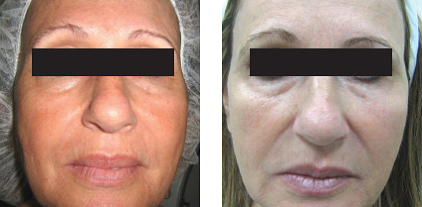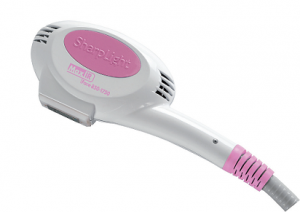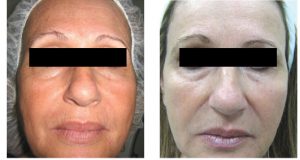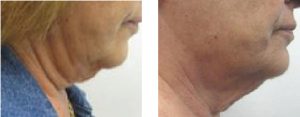CONTACT US

Infrared Technology for Skin Tightening – A Hot Topic Utilizing Deep Dermal Heating

Dr. Betty Czajkowsky, M.D., Nov. 2012
M.D. SharpLight’s Medical Advisor
Introduction
A non coherent, selectively filtered IR (infrared) device emitting infrared light in multi-second cycles has been developed with the intention to provide dermal heating. Water, as the target chromospheres, allows uniform heating of the targeted skin tissue volume. A tailored wavelength spectrum from 850 to 1,750 nm on one hand sufficiently absorbed by intracellular and extracellular water allows a penetration depth of 5 mm into the skin which is ideal for targeting the reticular dermis. A multi second exposure is used with sufficient energy to create the desired combination of time and temperature for collagen contraction. The epidermis is protected through contact cooling. This allows for heating of the treated tissue without epidermal damage.
Collagen is a polymer that exists as a triple helix with chains held together by hydrogen bonds.
These molecules are aggregated and organized as fibrils with tensile properties attributable to intermolecular cross-links. When collagen is denatured by heat, the intra molecular hydrogen
bonds rupture and the triple helices “unwind to produce a gel of random-coil molecules.” Tissue tension in human skin increases because, although the fibers become shorter, the heat-stable cross-links between molecules are maintained,thus increasing the rubber-elastic propertiesof the collagen polymer. The heat-modified tissues then undergo remodeling associated with fibroplasias and new collagen deposition. When denaturation is complete, further increases in temperature result in additional fiber shortening, probably because of peptide bond hydrolysis.
The mechanism of collagen shrinkage has been described in detail. The temperature at which collagen shrinkage occurs is often quoted as 65° C. According to this equation, shrinkage of collagen depends on time, as well as temperature, and collagen contraction occurs at a variety of time-temperature combinations rather than at a specific temperature. That said, it has been suggested that for millisecond exposures, collagen shrinkage will occur only at temperatures exceeding 85º C, whereas for exposures of several seconds, shrinkage will occur at 60º to 65º C. Collagen contraction begins to occur at approximately 55º C. This is caused by the spread of heat to the deeper reticular dermis.
The IR infrared spectrum is both predictable and easily understood based on the known coefficients to the target chromospheres of water. SLT uses a unique spectral profile between 850 nm to 1750 nm. This IR source outputs from 20J/ cm2 to 35J/cm2 , based on the area being treated, resulting in heating at depths from 1-3 mm. The epidermal temperature is kept at a safe level of below 40°C by an integrated thermoelectrically cooled sapphire window which also assists in maintaining patient comfort during the treatment.
This unique IR spectrum creates a “dual clinical effect” of immediate skin tightening together with long term new dermal collagen formation. The primary function of this device is tightening of skin laxity on the face, cheeks and neck areas. Pain levels are reported to be well tolerated. The device is also intended for smoothing of facial wrinkles as a result of the neocollagenesis phenomenon.
Materials and Methods
An IR halogen lamp hand piece for the SharpLight Formax Plus and OmniMax devices has been tested on twenty (20) volunteers, all females, aged between 45 and 65, with various degrees of lax skin in the face, neck and arms. The twenty (20) volunteers received six (6) treatments, twice a week for 3 months. Standardized photographs were taken at baseline, and after the 6th treatment. 6 months follow-up visit was also assessed. Patient satisfaction scores were recorded at the final visit. Each session’s data was recorded for future evaluation.
Hand pieces come in 2 spot sizes: 3.4 cm2 and 6.4 cm2. Fluence values are up to 35 J/ cm2.
It quickly became clear that a greater amount of collagen denaturation can be induced with multiple passes, 3 or more, depending on the severity of the laxity of the skin.
Passes are performed over the entire designated treatment area, with additional passes over
the areas of more concern. The neck is treated directly in the sub mental area. At these settings, the procedure is very well tolerated. It is recommended to lower fluences over bony areas. These areas have been found to be especially sensitive in many patients and treatment of this area is often avoided. On certain more sensitive areas the fluences are usually lowered due to discomfort. If the patient mentions an immediate burning sensation after the pulse, a cold pack should be applied immediately to prevent tissue burns. Immediately after treatment, diffused mild erythema with slight edema is evident in the area, but it usually fades within 1 hour.
Physicians are currently using IR in two distinct treatment approaches. One method is to use the highest tolerable fluences. The second method is to use lower fluences with a higher number of pulses in concentrated areas.
Physicians are currently using IR in two distinct treatment approaches. One method is to use the highest tolerable fluences. The second method is to use lower fluences with a higher number of pulses in concentrated areas. In this comparative conclusion, IR is effective for the following reasons:
1. Greater safety profile, more predictable.
2. Equal or near equal in dermal heating capability.
3. Superior epidermal cooling method.
4. Scalable platform.
Patient selection
Best results are often seen in patients with a minimum of excess fat in the area of concern and with thinner skin that is easily moved with a gentle touch.
Patient’s should be able to tolerate the treatment with no more than a moderate level of discomfort.
Treatments are commonly performed twice a month; every 3-4 weeks is also effective, but visible
results are not as fast . Maintenance should be done every 6 months to keep the skin tightening results. usually fades within 1 hour.
| Redness and heat sensation lasting for about 30 minutes after the session |
SLT IR 6.4 handpiece.
Also available with a 3.4 spot size.
Results
At 1 month after the last treatment, 70% of the subjects exhibited moderate to significant improvement in skin laxity and skin texture of face and neck. Patients reported high overall satisfaction with the treatment. No serious complications were recorded.
• Face and neck had a positive subjective evaluation after 8 treatments.
Patient satisfaction scores:
• Very satisfied 70%
• Satisfied 20%
• Not satisfied 10%
Treatment phases
Full cycle lasts approximately 10 seconds.
• OFF Pulse Pre-Cooling, through the sapphire window is regulated at around 10° C, and is achieved without pressing the pedal.
• ON Pulse Dermal heating with infrared light, with simultaneous and continue epidermal cooling, is achieved with a continuous pressing the pedal.
• Treatment phases -Full cycle lasts approximately 10 seconds.
• OFF Pulse Pre-Cooling, through sapphire window regulated at around 10° C, is achieve without pressing the pedal
• ON Pulse Dermal heating with infrared light, with simultaneous and continue epidermal cooling, is achieve with a continuous pressing the pedal
• Post-Cooling is achieved without pressing the pedal
Conclusion
The IR treatment has demonstrated to be highly effective and safe for non-invasive face skin
tightening. Quantitative and qualitative results were documented in the treatment of face and neck skin laxity and improved texture and of sagging of arms. Very high patient satisfaction was achieved. The procedure is easy to apply, involves no discomfort to the patient and requires no downtime whatsoever. Periodic maintenance sessions may be administered as required or desired by each individual patient. The availability of IR treatment significantly enhance
the capabilities of SharpLight’s Formax Plus and OmniMax devices, broadening its clinical indications to increase results of skin tightening.
B/A PHOTOS
Before After 8 sessions
Before After 4 sessions
Referencesc
1. Clinical and histopathological results following TriPollar radiofrequency skin treatments. Kaplan H, Gat A. J Cosmet Laser Ther. 2009 Jun;11(2):78-84.
2. Nonsurgical nonablative treatment of aging skin: radiofrequency technologies between aggressive marketing and evidence-based efficacy. Atiyeh BS, Dibo SA. Aesthetic Plast Surg. 2009 May;33(3):283-94. Epub 2009 May 13.
3. Monopolar radiofrequency treatment of human eyelids: a prospective, multicenter, efficacy trial. Biesman BS, Baker SS, Carruthers J, Silva HL, Holloman EL. Lasers Surg Med. 2006 Dec;38(10):890-8.
4. Is topical anesthesia useful in noninvasive skin tightening using radiofrequency? Kushikata N, Negishi K, Tezuka Y, Takeuchi K, Wakamatsu S. Dermatol Surg. 2005 May;31(5):526-33.
5. Non-ablative skin tightening with radiofrequency in Asian skin. Kushikata N, Negishi K, Tezuka Y, Takeuchi K, Wakamatsu S. Lasers Surg Med. 2005 Feb;36(2):92-7.
6. Selective electro-thermolysis in aesthetic medicine: a review. Sadick NS, Makino Y. Lasers Surg
Med. 2004;34(2):91-7. Clinical applications of radiofrequency: nonsurgical skin tightening odgkinson DJ. Clin Plast Surg. 2009 Apr;36(2):261-8, viii.
7. The nonablative radiofrequency for rejuvenation. Sukal SA, Geronemus RG. Clin Dermatol. 2008 Nov-Dec;26(6):602-7.
8. Tissue tightening: a hot topic utilizing deep dermal heating. Gold MH. J Drugs Dermatol. 2007
Dec;6(12):1238-42 Clinical, laboratory, and MRI analysis of cellulite treatment with a unipolar radiofrequency device. Goldberg DJ, Fazeli A, Berlin AL. Dermatol Surg. 2008 Feb;34(2):204-9; discussion 209. Epub 2007 Dec 17.
9. Bipolar radiofrequency in the treatment of dermatologic imperfections: clinicopathological and immuno histochemical aspects. Montesi G, Calvieri S, Balzani A, Gold MH. J Drugs Dermatol. 2007 Sep;6(9):890 6.
10. Nonablative cutaneous remodeling using radiofrequency devices. Alster TS, Lupton JR. Clin Dermatol. 2007 Sep-Oct;25(5):487-91.
11. Nonsurgical tightening of skin laxity: a new radiofrequency approach. Rusciani A, Curinga G, Menichini G, Alfano C, Rusciani L. J Drugs Dermatol. 2007 Apr;6(4):381-6.
12. Monopolar radiofrequency skin tightening. Abraham MT, Mashkevich G. Facial Plast Surg Clin North Am. 2007 May;15(2):169-77, v.
13. Skin tightening with a combined unipolar and bipolar radiofrequency device. Mayoral FA. J Drugs Dermatol. 2007 Feb;6(2):212-5.
14. The role of deep heating for noninvasive skin rejuvenation Dierickx CC. Lasers Surg Med. 2006
Oct;38(9):799-807.
15. Monopolar radiofrequency facial tightening: a retrospective analysis of efficacy and safety in over 600 treatments. Weiss RA, Weiss MA, Munavalli G, Beasley KL. J Drugs Dermatol. 2006 Sep;5(8):707-12.
16. Monopolar radiofrequency. Burns JA. Aesthet Surg J. 2005 Nov-Dec;25(6):638-42. Nonablative radiofrequency treatment of facial laxity. Fisher GH, Jacobson LG, Bernstein LJ, Kim KH, Geronemus RG. Dermatol Surg. 2005 Sep;31(9 Pt 2):1237-41; discussion 1241.
17. Multipass vector (mpave) technique with nonablative radiofrequency to treat facial and neck laxity Finzi E, Spangler A. Dermatol Surg. 2005 Aug;31(8 Pt 1):916-22.
18. Current concepts in nonablative radiofrequency rejuvenation of the lower face and neck. Abraham MT, Vic Ross E. Facial Plast Surg. 2005 Feb;21(1):65-73.
19. Radiofrequency nonablative tissue tightening. Koch RJ. Facial Plast Surg Clin North Am. 2004
Aug;12(3):339-46, vi.
20. Improvement of neck and cheek laxity with a nonablative radiofrequency device: a lifting experience. Alster TS, Tanzi E. Dermatol Surg. 2004 Nov;30(11):1430; author reply 1430.
21. Non-surgical radiofrequency facelift. Narins DJ, Narins RS. J Drugs Dermatol. 2003 Oct;2(5):495-500.
22. The medical face lift: a noninvasive, nonsurgical approach to tissue tightening in facial skin using nonablative radiofrequency. Ruiz-Esparza J, Gomez JB. Dermatol Surg. 2003 Apr;29(4):325-32; discussion 332.
23. Circumference reduction and cellulite treatment with a TriPollar radiofrequency device: a pilot
study. Manuskiatti W, Wachirakaphan C, Lektrakul N, Varothai S. J Eur Acad Dermatol Venereol.
2009 Jul;23(7):820-7. Epub 2009 Apr 8.








